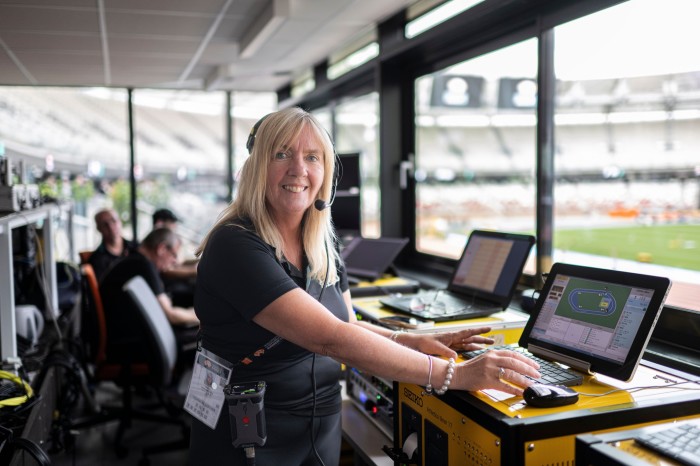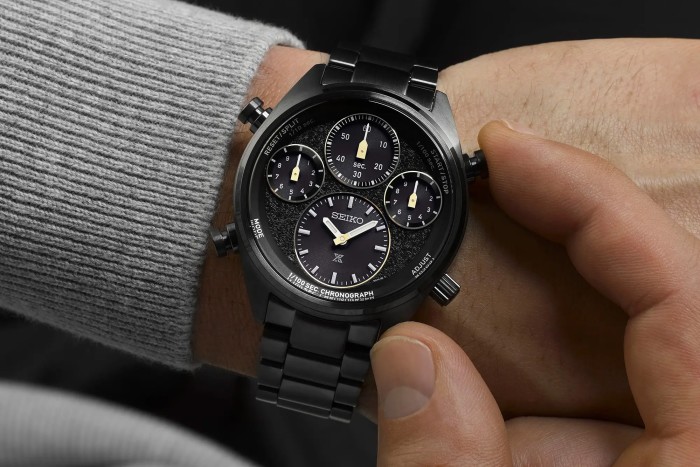What does a sport ‘timing partner’ actually do?

Roula Khalaf, Editor of the FT, selects her favourite stories in this weekly newsletter.
As sprinters powered down the straight in the men’s 100 metres final (pictured above) at the World Athletics Championships in Budapest in August, Karen Washington armed the infrared laser beam at the finish line that would give the unofficial time. Official times are calculated from an athlete’s torso using cameras capable of capturing up to 10,000 frames per second.
She had the same job when Usain Bolt ran his world record time of 9.58 seconds in Berlin in 2009. “I do feel like I never wanted him to break it [again] because it was my record as much as his,” she says.
We are speaking while overlooking the track at the National Athletics Centre, beside the Danube river, two days before the competition in Hungary gets under way. Washington is one of 65 people working for Seiko to help fulfil its role as official timekeeper to the championships.
With the event covered by 46 broadcasters, and media and photographers from 75 countries, this side of its business boosts global brand awareness for the Japanese watchmaker.
Since the Tokyo Olympics in 1964, Seiko has provided timing and measurement services for sports ranging from swimming to speed skating. It has held a contract with World Athletics since 1985, timing its first World Athletics Championships in Rome in 1987.
The seven-person Seiko Timing Services team in the UK, which collaborates with external specialists, oversees this partnership from a warehouse in Crewe, north-west England, where it has workshops for testing equipment.


“We’re always striving to make things more accurate, more reliable, and that’s where a lot of camera technology comes in because it allows things to be reviewed; you don’t have to make a split decision in the moment,” says Laurie Needham, research and development manager at Seiko Timing Services, who has a PhD in biomechanics. “But also it’s about getting the information back faster to make the competition run more smoothly — so it’s ultimately more entertaining for people to watch.”
In Budapest, the team is launching its newest innovation: the triple jump phase measurement. Developed over the course of nearly three years, this system uses a camera — capable of recording 60 frames per second — placed high above the runway. Artificial intelligence uses the images to track an athlete’s movements through their hop, skip and jump, producing data for the distance, height and speed of each of these phases.
The data is to help broadcasters “tell the story” of the event but could be used by athletes to improve their performance, says Needham.
“It’s a bit of a change for us, in terms of moving from not just doing precision timing and measurement [but] also providing entertainment data that broadcast and TV can use to help people understand how somebody has done better than someone else,” he explains. “It might be that one athlete hits their top speed five metres before take-off but another athlete hits top speed one metre before and maybe that’s what’s helping them to go further.”

The new system runs alongside video distance measurement (VDM), for which two high-resolution cameras capture an athlete’s landing in the sandpit. A separate jump management system, similar to the now-ubiquitous video assistant referee tool in football, uses a camera capturing 300 frames per second to show the point where an athlete takes off from the board. A judge sitting between the Seiko employees operating these systems uses the information to determine the validity of a jump.
Most people working for Seiko Timing Services at the championships have full-time jobs in other professions. Washington, an accountant who runs a road haulage company with her husband Ian, first joined the timing team for the Barcelona Olympics in 1992. She had been working as a buyer at Seiko’s UK headquarters when the company sought additional graphics operators. It was a fortuitous decision: she met Ian, who was operating the false start equipment at the time.

Leading the team in Budapest is Daniel Jones, event manager for Seiko Timing Services. When we meet, he has already been on site for more than 10 days overseeing the set-up of the 2,000 items of equipment (not including individual cables) that arrived in six 13-tonne trucks from the UK and one container from Japan.
His team operates everything from the trackside clocks and field event boards to the local precision system providing data on track athletes’ individual performances for television purposes. Seiko Timing Services is in the latter stages of developing video tracking that will eliminate the need for athletes to wear tags, which use ultra-wideband technology, behind their bibs. It is also looking at replacing the laser-based electronic distance measurement used for long throws (javelin, hammer and discus) with a camera-based VDM system similar to that already used for shot putt.
For the false start system, track athletes’ blocks are calibrated to detect whether anyone reacts before the gun is fired or the reaction time of 0.1 seconds. A waveform shows illegal motion. Video footage from both behind and in front of the athletes supports the judge in making their decision on whether to disqualify someone.
“In all those processes we are just giving information to the right judges and it’s down to them to make the right decision,” says Jones.

Seiko reflects its expertise in precision timing in its Prospex Speedtimer watch series. Demand for its 2023 World Athletics limited-edition solar chronograph, with a 1/100th of a second counter and dial mimicking the texture of the running track, was five times greater than predicted in the brand’s Budapest store, according to Attila Lichtenberger, general director, Seiko Boutique Budapest and Seiko Hungary.
In the UK, traffic to the Seiko Boutique website increased by 15 per cent during the eight-day championships, compared with the previous eight days, and the limited-edition model was the top-selling Prospex design in the week leading up to the event.
With the demands on Seiko Timing Services shifting more towards the “entertainment factor”, Jones hopes there will be collaboration between the “funner side” of his department’s work and Seiko watchmaking. However, he knows that the two are already linked. “We’re here to promote the watches at the end of the day and the brand of Seiko,” he says.
Comments